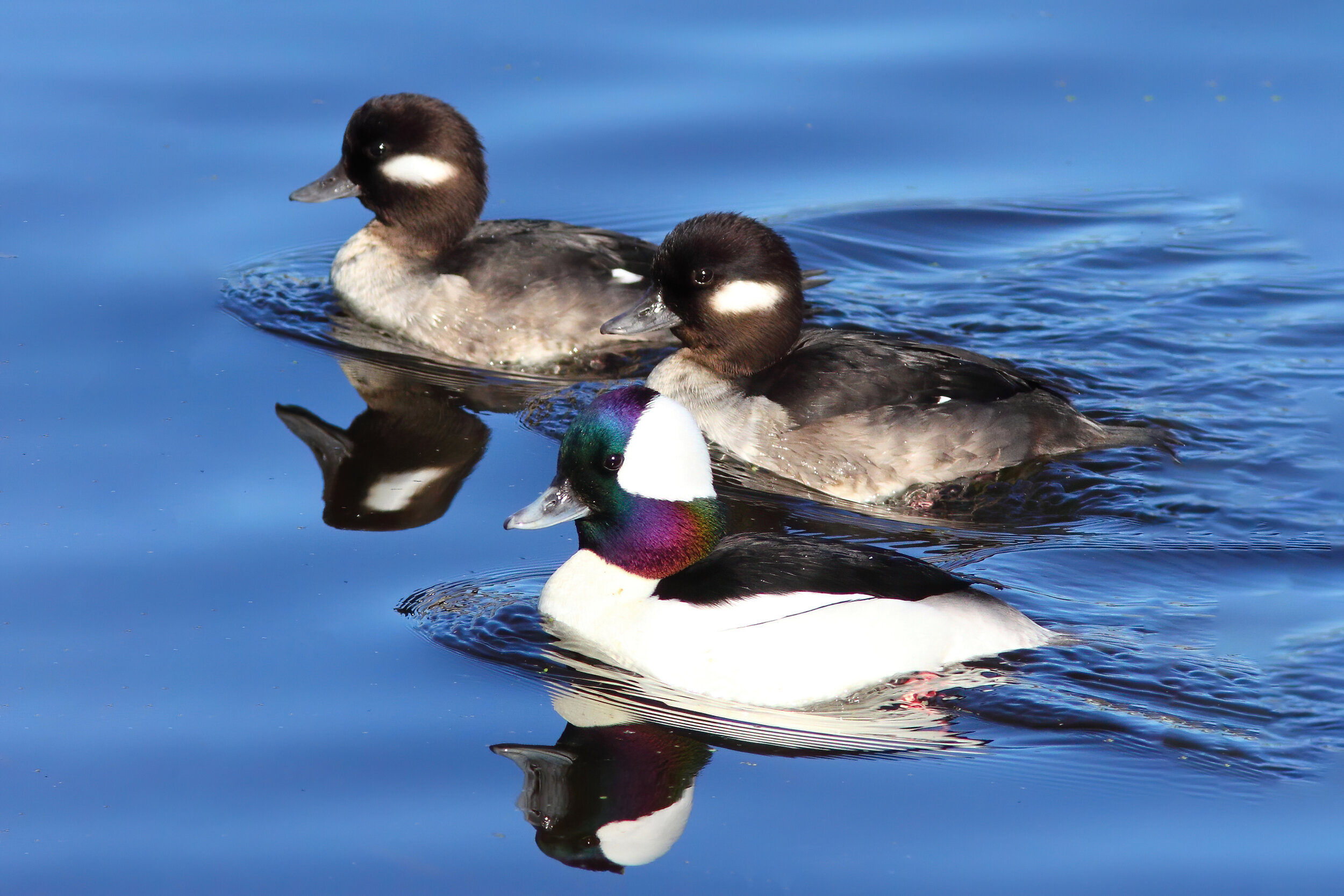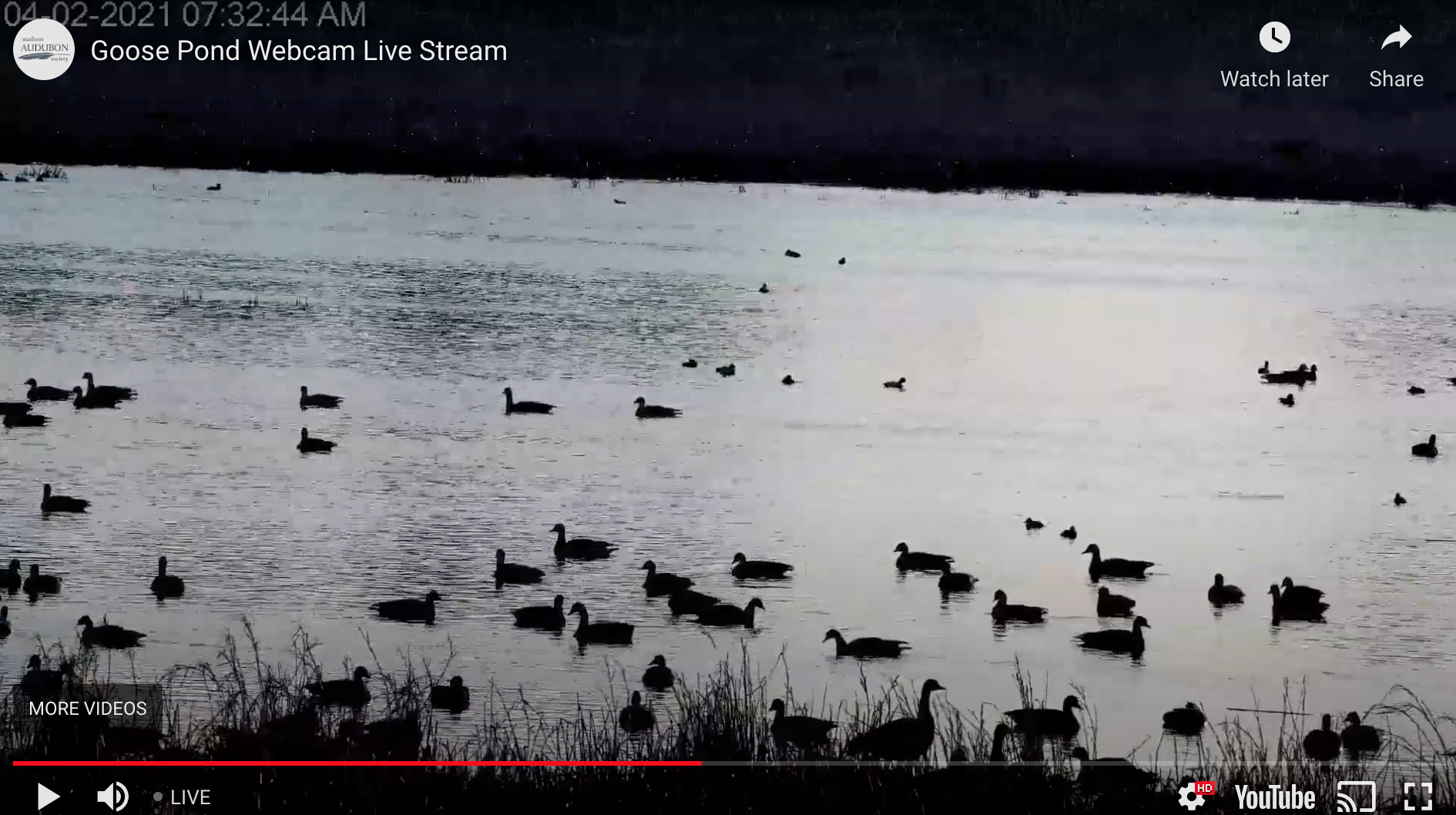We always enjoy seeing buffleheads in spring migration. They arrive early shortly after the pond is open and in some years a few birds can still be found in late April.
A trio of buffleheads. Photo by Mick Thompson FCC
The males are easy to identify with their large area of white in the head and a lot of white on the body. Females are brownish with a white spot in the back of the head. Their scientific name is Bucephala albeola. The genus name refers to the oddly bulbous head shape and the species name refers to the large sound of white on the males body. They are sometimes referred to as “sea ducks” since many winter on the ocean or gulf shores.
The Cornell Laboratory of Ornithology report on buffleheads includes:
Range map courtesy of Cornell Lab of Ornithology
“Bufflehead breed near ponds and lakes in boreal forest and aspen parkland of Canada and Alaska, with isolated populations in the western United States. The Bufflehead’s breeding range is limited by the distribution of Northern Flickers, which are their main source of nesting cavities. Buffleheads are North America’s smallest diving duck; they benefit by using old flicker nests. They can also nest in old pileated woodpecker cavities but there they have to compete with common goldeneyes.
Medium-distance migrant. Bufflehead that breed west of the Rockies migrate to the Pacific Coast, while those that breed in central Canada migrate east or south. Bufflehead in Alberta split up entirely, with some heading east, some west, and some toward the Gulf Coast and the Southwest.”
In 1978 buffleheads began nesting in wood duck boxes at the Agassiz National Wildlife refuge in northwest Minnesota. The number of breeding pairs increased overtime and breeding surveys on the refuge from 2004 to 1014 found on average over 300 breeding pairs per year.
Photo by Marilylle Soveran FCC
In 1991, Sam Robbins wrote in Wisconsin Birdlife that there was one nesting record near Pewaukee probably sometime between 1866-1883. It was not about 2010 that Jeff Bahls working at Horicon Marsh State Wildlife Area found a pair nesting in a wood duck box. Over the next four years ending in 2014 Jeff found 3-4 broods of buffleheads. Since then no pairs have been found nesting.
Bufflehead populations are stable and despite indication of declines in some areas, overall their population increased between 1966 and 2014 according to the North American Breeding Bird Survey. Christmas Bird Counts also show a steady increase in Bufflehead numbers between 1927 and 1992. The last overall population estimate was 1.4 million buffleheads in 1992.
This year has been a good year for bufflehead sightings at Goose Pond. On March 29th, the Wisconsin Society for Ornithology had a field trip to Goose Pond and the bird watchers were entertained by seeing a flock of about a dozen buffleheads flying near them. Jim Otto, Goose Pond volunteer, mentioned that buffleheads seem to be in higher numbers this year. Buffleheads are also found in fall migration. John Romano reported the high count for Goose Pond at 120 on November 30, 2009.
The webcam is very useful for counting waterfowl numbers. On April 1st, JD Arnston panned the west pond with the Goose Pond Webcam over a 14 minute period around 6:00 p.m. We chose this time since most of the Canada geese were out feeding in the picked corn fields. We played back the webcam stream and counted 60 buffleheads. It is easier to count waterfowl using the camera since we could zoom into the far back northwest corner of the west pond.
Bufflehead photo by Andy Reago & Chrissy McClarren
We had a high count of around 500 lesser scaup and around 100 ring-necks. Other diving ducks seen included canvasbacks, redheads, and ruddy ducks. There were a pair trumpeter swans swimming around the west pond. Trumpeters nest at Schoeneberg Marsh Waterfowl Production Area three miles to the northeast. It would be nice to have a pair nest at Goose Pond.
Goose Pond Webcam
You can check out what’s happening on Goose Pond from home by visiting the Goose Pond Webcam page: madisonaudubon.org/pond-cam. The stream allows you to see the pond 24/7 from wherever you are. And, extra bonus: you can pause and rewind if you see something especially interesting!
If the Madison Audubon website says that the Webcam is not streaming click on the YouTube small box on the lower left corner. Sometimes we take the stream down for maintenance. During those times, the stream will be unavailable, but we will get it back up and running as quickly as possible. If the Madison Audubon website says that the Webcam is not streaming click on the YouTube small box on the lower left corner. You can also subscribe to Madison Audubon's YouTube page so that you can get alerts for when the stream comes back up.
With YouTube you can also go to the bottom red line on the screen and back up the video for the past 12 hours. It is nice to be able to back up to see what is happening around sunrise and sunset.
We wondered what bufflehead numbers looked like in the past. We picked out an early record book and searched our entry for April 1st, 1984. The west pond opened up that day and no buffleheads were present. They appeared shortly after the ice opened but we never had more than eight buffleheads on a report for spring migration.
Scope Day on APRIL 1, 1984
April 1, 1984 was on a Sunday. We advertised that Sunday as a “Scope Day” with the help of Ken Wood. The big, bird attraction was 850 tundra swans. Many people were birding and “sometimes cars in line from turnaround (on Prairie Lane) to the (Goose Pond) road”. Visitors included George Archibald *, the Wilber Brown family, Betty Bunge, Valorie Bulingham, Tom Dietmer, Joe Hickey *, Ruth Hine*, Harriet Irwin, Carol Luetkins, Vic and Sally Martin (Mark’s parents), Micheal Nelson, Barb Shaw and her husband, Ken Wood, Jim and Libby Zimmerman*. Also birding were 25 students from Wildlife Ecology.
Most people left before 5:30 p.m. when the excitement started. The train came by throwing out sparks and starting fires near our pine covered hill. We ran to the house, called the Arlington Fire Department, and picked up some fire equipment. Then we went to work and put out one fire with swatters and were working on another fire when the five fire trucks arrived. Mark went with some firemen and he began lighting a backing fire near where the water crosses under the railroad tracks before entering the pond. Entry reads “hot, but got the line in and finished by 7:30 p.m. Bill Bell, Fire Chief called later and said to “watch the train on its way back (later that night)—they (DNR) were going to impound it tomorrow.”
An aside *. The Wisconsin Conservation Hall of Fame is inducting their 100th member on April 24, 2021. It is interesting that four of the 100 members were at Goose Pond that day—George Archibald, Joe Hickey, Ruth Hine, and Jim Zimmerman.
This year the induction ceremony will be virtual and will include 2020 inductees Steve Born, UW-Madison Professor in Environmental Planning, Stan Temple who took over for Joe Hickey in the UW-Madison Wildlife Ecology Department, and for 2021 #100 Gary Eldred who founded The Prairie Enthusiasts. You are welcome to join the celebration https://wchf.org/
Written by Mark Martin and Susan Foote-Martin, Goose Pond Sanctuary resident managers









